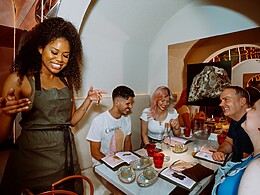
National Rosé Day (June 9) is almost upon us and we want to be sure you’re fully prepared to drop all your sophisticated wine knowledge on your friends. And since rosé just recently seemed to jump on the popular train of thirsty gals, we needed a little lesson in the pink drink too. To help us out, we turned to Ryan Gardner, the house wine steward at The Henry (umm dream job?) who spends his days spreading the love of wine. He keeps the Reserve List up-to-date with a variety of choices and helps school staff, guests and parties on picking out the perfect vino. And since he’s a third-generation native of Arizona, he knows a thing or two about how to cool down on a hot summer day — particularly with a glass of rosé in your hand.
Keep reading to learn what to pair rosé with, Ryan’s affordable picks, an easy cocktail recipe and more. You’re welcome.

AFM: What exactly is rosé? How does it differ from a red or white?
Ryan Gardner: What is rosé, you ask? In a word: Delicious. How does it get that happy pink color? To get into that we have to wrap our heads around how wine (all red wine) gets its reddish color. Color comes from the wine’s contact with the skins of the grapes. The longer the contact, the deeper the hues. Rosé is made with several red grape varietals (Grenache, Syrah, Cabernet Franc, etc.) but instead of being exposed to the skins for days at a time, the fermented grape juice is only in contact for a matter of hours; thus it shows a vibrant pinkish instead of a deep red.
AFM: What should a good rosé taste like?
RG: Most rosés should sport refreshing, bright flavors of rose petals, rhubarb, and citrus. Perfect for relaxing poolside on a hot day, no? The rise in its popularity comes, in part, from its versatility and ability to be the friend that everyone hopes will show up at the party. Never a bad time when rosé is around!
AFM: What type of food does rosé pair with?
RG: Like most things in life, it depends on the occasion. The “reason for the season” so to speak. At a friend’s party enjoying a charcuterie plate with creamy cheeses and fat-marbled prosciutto? You may want a drier rosé (less or no residual sugar) to clear your palate for the next savory, indulgent bite. Digging into crazy Uncle Bob’s atomic guacamole that’s hotter than an Arizona dashboard on an afternoon in July? Try a sweeter rosé. The residual sugar will cool the palate and get it back into a happy place. Remember: sweet cancels heat!
AFM: For someone who knows nothing about rosé, what’s some foolproof advice on picking the right one?
RG: Step 1: Know your palate! How do I get to know my palate, you ask? The answer is fun and simple: Drink more rosé! Try different styles and see where your preferences play. Once you build a library of options, that’s where the real fun begins!
Step 2: Check the region! The flavor profile of a French rosé of Grenache can differ greatly from a California rosé of Pinot Noir.
Step 3: Write it down! An occupational hazard of tasting wine is forgetting the tasting notes! It’s not a crime to have something to go back and reference.
Step 4: Remember that no one knows everything about wine… and that’s ok. Once we embrace this fact it becomes a little more accessible and a lot more fun!
AFM: What are your top picks for affordable rosés that someone can buy at the store?
RG: When choosing a wine off the grocery store shelf there’s a couple of things to factor into the equation. Generally speaking, the number on the price tag represents the time, effort and expertise involved in the finished product. You’d be surprised by how much the quality leaps by bumping the acceptable price range from $10-$15 up to $25-$30 and above. Below-$20 picks include Mumm (Sparkling) Rosé and Josh (Still) Rosé.
AFM: What’s an easy recipe for a rosé cocktail?
RG: It is said that one must party to the beat of their own drum and sometimes we go for an inventive way to spruce up an already fine and excellent beverage. Good rosé is meant to be enjoyed for its lifted and bright flavors so I recommend that if the perfect move to liven up the moment is to concoct a cocktail made with rosé, do your best not to spend more than $15 on what will become a cocktail ingredient. Ok, disclaimer over, onward to a fun rosé cocktail!
Things you’ll need:
- Shaker tin
- Ice
- .5 oz. Fresh squeezed lime juice
- .5 oz. St. Germain Elderflower liqueur
- .25 oz. Grapefruit liqueur (I used Giffard Pamplemousse)
- 1.5 oz. Hendrick’s Gin
- Rosé (preferably sparkling)
What to do: Add lime juice, St. Germain, grapefruit liqueur, gin and ice to a shaker tin and SHAKE, SHAKE, SHAKE. Empty whole contents into a glass (perhaps one that is festive in nature?) and top with rosé (all day??) … yep, all day. Smile and enjoy!

For more information on The Henry, visit: thehenryrestaurant.com
For more on where to enjoy rosé in the Valley and to celebrate National Rosé Day, click here.










